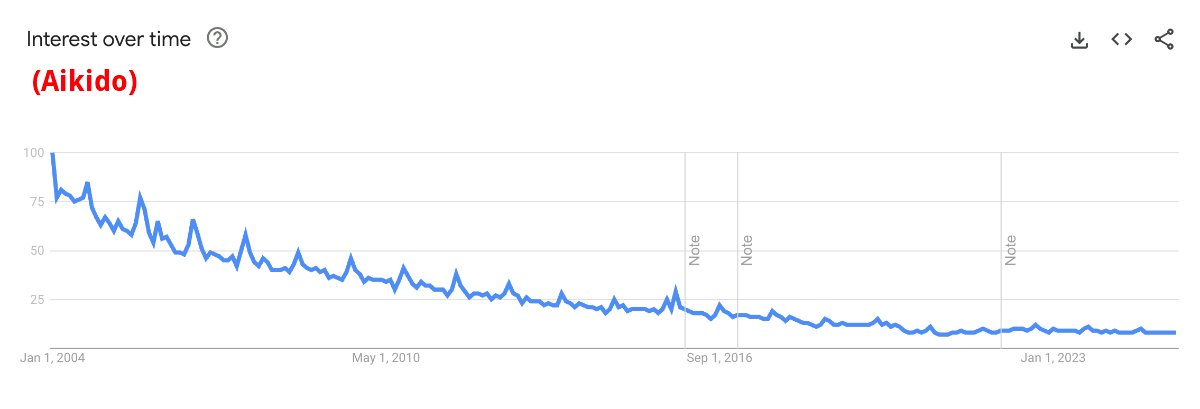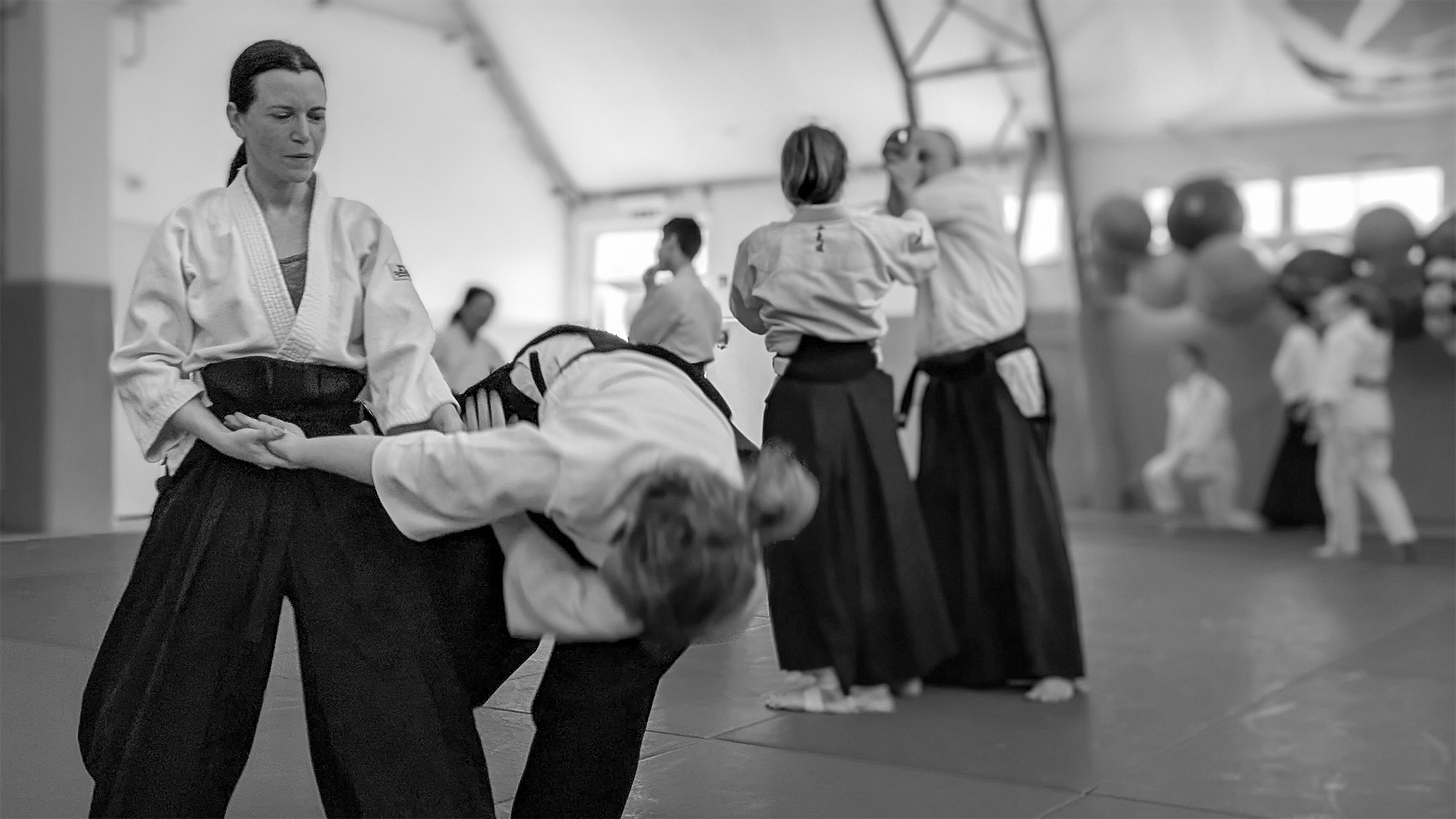The future of Aikido: 11 challenges and community insights
By the time you realize you’ve inherited something, it’s already yours to protect — or let go.
I recently posted this question on Reddit:
The future of Aikido — how do you see it? And what would you change (or protect) to help it grow or evolve?
Accompanied by this graph from Google Trends:
We’re living through a slow, visible decline in Aikido’s global relevance. Cultural shifts, the rise of MMA and BJJ, questions of effectiveness, relevance, tradition, reputation, and evolution — the reasons are many.
But I didn’t ask for blame — I asked fellow practitioners for insight.
Here’s what came back: 11 sharp, sincere perspectives from people who still show up on the mat.
TL;DR
Aikido is facing both an image crisis and an internal crossroads.
There is no consensus — and that’s part of its identity.
Some want evolution: pressure, realism, new teaching methods.
Others want preservation: less noise, more clarity, simpler joy.
Everyone cares — and what they want is sincerity.
1. Poor perception of martial value.
Insight: We need to move beyond preservation and into participation. Aikido will not survive by preserving ashes — we must carry the fire. Making the art our own, with humility and respect for lineage, is not betrayal but continuity.
“We are the current generation, it is our responsibility to keep breathing life into the art... We cannot expect O'Sensei or any of the old masters to propagate it from the grave.” — UncleBiroh
2. Resistance to evolution vs. relevance to modern combat sports.
Insight: Some arts fossilize beautifully — but Aikido may not be one of them. We can either polish tradition like a museum piece or let it breathe and adapt. Both choices come with sacrifice.
“You can either agree to preserve it in amber... or you can try to evolve it.” — DukeMacManus
3. Aikido lacks pressure testing and real-world application.
Insight: Without feeling the heat of real resistance, our skills remain theoretical. Introducing failure-friendly pressure — not to win, but to awaken — may be key to making training feel alive again.
“The samurai train kata (the known) to prepare for the battlefield (the unknown)... it is okay and useful to fail and make mistakes.” — Ruryou
4. Poor reputation, mocked in the U.S. compared to respect in Europe.
Insight: Aikido’s image has been shaped by misrepresentation as much as by mastery. Holding higher standards, embracing media, and addressing the fantasy-fueled performances might slowly restore credibility.
“Too much of that Jedi Aikido stuff on YouTube... Maybe the Aikikai needs to start getting stricter with giving out ranks.” — bossaboom
5. Aikido doesn’t meet expectations of effectiveness in youth.
Insight: Younger students don’t seek philosophy — they seek answers. Acknowledging their “what-if” questions with honest exploration rather than canned tradition could be a bridge.
“The kinds of questions kids ask are revealing... sometimes tough to answer with purely traditional Aikido responses.” — startupwithferas
6. Mismatch of expectations — fighting art vs. philosophy.
Insight: Selling Aikido as a fighting art sets it up for disappointment. Reframing it as a path for health, awareness, or movement could meet people where they are — honestly.
“Aikido can reinvent itself as a health art... stop pretending to be a fighting art when it is not.” — DukeMacManus
7. Aikido is miscommunicated — people misunderstand what it actually is.
Insight: Aikido isn’t a combat sport. Trying to compare it to MMA or BJJ misses the point entirely. Better communication about its nature — as a developmental art, not a competition — could prevent disillusionment.
“Aikido is a martial art, BJJ and MMA are combat sports... They are addressing two different target groups.” — ZeroGRanger
8. Excessive debate on tradition and purity.
Insight: What if we stopped trying to define Aikido as either-or? Tradition and evolution aren’t mutually exclusive. Respect doesn’t require rigidity.
“Aikidō is broader than a single interpretation... It’s not about techniques, but about energy.” — Heavy-Employer-3186
9. No clear communication of goals or unique value.
Insight: Aikido’s message gets lost in comparison. If we clarified who we’re for — not who we’re against — we might draw in the right people, and keep them longer.
“The biggest problem Aikido has is that it tries to be in competition with combat sports... That difference needs to be communicated better.” — ZeroGRanger
10. Lack of positive online community for Aikido.
Insight: Digital dojos matter too. If every online space feels like a critique, not a community, newcomers won’t stick around. We need more joy, more storytelling, more visible love for the art.
“Sometimes it feels even the place that’s supposed to be for Aikido... is filled with people telling me I’m wasting my time.” — AikiThrowaway
11. Some just want to practice in peace
Insight: And finally, not everyone wants to change the art. Some simply enjoy it as it is. Growth doesn't have to mean overhaul — sometimes it means letting people connect with the art on their own terms.
“I like training Aikido just the way it is at my dojo. If I wanted BJJ/MMA/etc., I’d do that.” — Herdsengineers
“Leave it the way it is... to grow the skill of the practitioner.” — kimbapslice
Where Do We Go From Here?
Aikido is at a quiet crossroads. There’s no one answer, and maybe that’s the point.
But here’s what I didn’t hear enough about: how we teach.
Pedagogy matters. Students today arrive with different bodies, expectations, and cultural backgrounds. If we don’t meet them where they are — physically, socially, cognitively, and emotionally — we risk losing them right after they get stuck and before they start enjoying koshi-nage. 😉
One Small Offering
If you’ve ever felt stuck in your practice, or seen your students struggling to find “flow,” this piece may help:
👉 From Tension to Flow: Aikido training with clarity
It’s a practical framework based on three internal qualities — relaxation, stability, and clarity — that help shift Aikido from something performed to something embodied.
No mysticism. No dogma. Just mindful tools to help refine what you already feel — and bring it to life on the mat.
If something in this post resonates — or if you disagree — I’d love to hear from you.
What keeps you training?
What do you think Aikido still offers?
And what would you do to help it grow?
👉 Leave a comment. Or just reply with your own version of: “Why I still show up.”
I don’t know (yet) how we turn this around. But I still believe your voice matters.
—
Saša / Aikicraft




